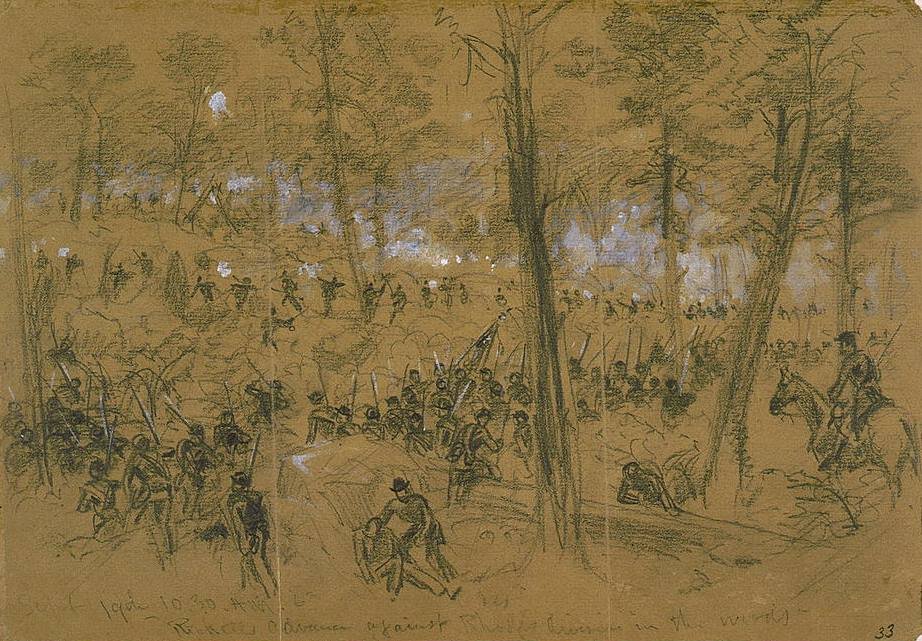
The Third Battle of Winchester
September 19, 1864
“The veterans of Stonewall Jackson fired amazingly low, so that the grass and earth in front of the regiment was cut and torn up by a perfect sheet of lead.”
Sketch of Rickett’s division attacking in the West Woods
The Third Battle of Winchester was the largest and costliest battle ever fought in the Shenandoah Valley. More than 54,000 men fought and over 8,600 became casualties in a ferocious see-saw struggle that saw the Confederates gradually forced back until a final decisive attack by Federal infantry and cavalry struck the Confederate left flank, breaching the defenders’ lines and sending the Confederates “whirling through Winchester.”
In August 1864, Union Gen. Philip Sheridan was sent to the Shenandoah Valley to bring an end to Confederate control of the region. Uncertain of the size of Confederate Gen. Jubal Early’s army, and unwilling to risk a politically disastrous defeat, Sheridan was cautious at first, and the initial skirmishes between the opposing forces were relatively small and indecisive.
Sketch of Rebecca Wright meeting Thomas Laws
Early mistakenly believed that Sheridan’s caution reflected a lack of aggressiveness, and felt safe in dividing his forces between Winchester and Martinsburg to wreck the B&O railroad and threaten Maryland. Learning of Early’s risky maneuvers, and that one of Early’s divisions had left for Richmond (thanks to information from pro-Union Winchester resident Rebecca Wright smuggled to Sheridan by African-American Thomas Laws), Sheridan moved to attack early on September 19, but his slow advance through the narrow Berryville Canyon delayed his attack by hours – and gave Early time to concentrate his forces.
The battle raged all day on the hills east and north of Winchester. Early’s veterans decimated two divisions of the XIX Corps and a VI Corps division fighting in the Middle Field and near the Dinkle Barn – helped immeasurably by Maj. James Breathed’s artillery, positioned north of Red Bud Run (on the Huntsberry Farm), who sent cannon fire plowing into the flanks of the Union troops. Confederate division commander Maj. Gen. Robert E. Rodes and Union division commander Brig. Gen. David A. Russell were killed within a few hundred yards of one another in the heat of the fighting. Late in the afternoon a flanking movement by Crook’s corps and the Union cavalry finally broke Early’s overextended line north of town.
Third Winchester was one of the pivotal battles of the Civil War, and spelled the beginning of the end for Confederate primacy in the Valley. Additional northern victories at Fisher’s Hill (September 22), Tom’s Brook (October 9), and Cedar Creek (October 19), coupled with the devastation of the region’s agricultural bounty in the Burning, gave the Union permanent control of the Valley, aided Abraham Lincoln’s reelection, and helped speed the surrender of Robert E. Lee and the Army of Northern Virginia at Appomattox the following spring.
Sketch of Confederate forces retreating through downtown Winchester







